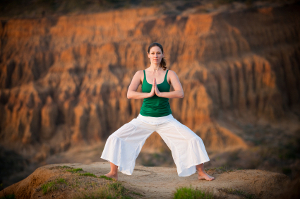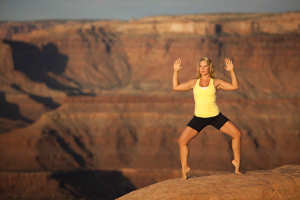
 Squats are a great way to tone your lower body fast! This pose, commonly called ”Goddess Squat, " is a standing, wide-legged squat that will challenge your muscles and your mind.
Squats are a great way to tone your lower body fast! This pose, commonly called ”Goddess Squat, " is a standing, wide-legged squat that will challenge your muscles and your mind.
The Sanskrit name for this pose, "Utkata Konasana" (oot-KAH-tuh cone-AHS-uh-nuh), comes from three words:
This literally translates to "Fierce Angle Pose, " and it can definitely feel fierce sometimes. The "angle" refers to the body's wide-legged stance; there are various arm positions you can take in the pose (see Modifications & Variations, below, for more information). Don't let the common name of the pose fool you — Goddess Pose is appropriate for all yoga students, including males! Keep reading to discover which variety of Goddess is best for you.
Benefits of Goddess Squat
This pose strengthens the entire lower body, including the glutes, hips, thighs, calves, and ankles. It opens the hips and chest, stretches the thighs, and elongates the spine. Goddess Pose helps to warm and energize the whole body. It improves balance, focus, and concentration. This pose also stimulates the respiratory and cardiovascular systems, while helping to relax the muscles of the pelvic floor. Goddess Pose is also highly beneficial for women who are pregnant, as squatting can create more room in the pelvis, making pregnancy, labor, and childbirth more comfortable.
Cautions
Do not practice this pose if you have a recent or chronic injury to the legs, hips, back, or shoulders. Always work within your own range of limits and abilities. If you have any medical concerns, talk with your doctor before practicing yoga.
Instructions
- Begin standing in Mountain Pose (Tadasana) at the top of your mat with your arms at your sides. Bring your hands to rest comfortably on your hips.
- Turn to the right and step your feet wide apart, about four feet. Turn your toes out slightly, so they point to the corners of your mat.
- On an exhalation, bend your knees directly over your toes and lower your hips into a squat. Work toward bringing your thighs parallel to the floor, but do not force yourself into the squat.
- Extend your arms out to the sides at shoulder-height with your palms facing down. Then, spiral your thumbs up toward the ceiling, so your palms face forward. Bend your elbows and point your fingertips toward the ceiling; your upper arms and forearms should be at a 90-degree angle.
- Tuck your tailbone in slightly and press your hips forward as you draw your thighs back. Keep your knees in line with your toes. Soften your shoulders. Gaze softly at the horizon.
- Hold for up to 10 breaths. To release, slowly return your hands to your hips. Keeping your spine upright, inhale as you press firmly into your feet and straighten your legs. Step your feet together and come back to the top of your mat in Mountain Pose.
 Modifications & Variations
Modifications & Variations
Goddess Pose will build outer and inner strength. If you’d like to deepen or lighten the pose, try these simple changes to find a variation that works best for you:









